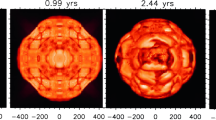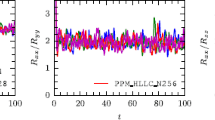Abstract
Understanding the nature of the standard engine behind core-collapse supernovae (SNe) has been an active area of research for over 60 yr pushing the limits of computational science. Driven by observations, scientists have developed and refined a model that not only explains existing observations but made predictions that have since been validated by subsequent data. Turbulent-driven convection plays a key role in this explosive engine and producing quantitatively accurate supernova models requires understanding this convection. Here, we review the convective-engine and discuss improved methods to study this convection to solve the supernova problem.


Similar content being viewed by others
Notes
As the supernova blasts through the circumstellar medium, it slows down, producing a reverse shock that runs back through the supernova ejecta, reheating it. This heating leads causes the remnant to light up and this is what we observe.
REFERENCES
F. Zwicky, Astrophys. J. 88, 522 (1938).
P. Podsiadlowski, Proc. Astron. Soc. Pacif. 104, 717 (1992).
K. Hirata, T. Kajita, M. Koshiba, M. Nakahata, Y. Oyama, N. Sato, A. Suzuki, M. Takita, Y. Totsuka, T. Kifune, et al., Phys. Rev. Lett. 58, 1490 (1987).
R. M. Bionta, G. Blewitt, C. B. Bratton, D. Casper, A. Ciocio, R. Claus, B. Cortez, M. Crouch, S. T. Dye, S. Errede, et al., Phys. Rev. Lett. 58, 1494 (1987).
P. Podsiadlowski, arXiv: 1702.03973 (2017).
P. A. Pinto and S. E. Woosley, Astrophys. J. 329, 820 (1988).
C. L. Fryer, A. L. Hungerford, and G. Rockefeller, Int. J. Mod. Phys. D 16, 941 (2007).
S. A. Colgate, M. Herant, and W. Benz, Phys. Rep. 227, 157 (1993).
M. Herant, W. Benz, W. R. Hix, C. L. Fryer, and S. A. Colgate, Astrophys. J. 435, 339 (1994); astro-ph/9404024.
C. L. Fryer and P. A. Young, Astrophys. J. 659, 1438 (2007); astro-ph/0612154.
C. L. Fryer and M. S. Warren, Astrophys. J. Lett. 574, L65 (2002); astro-ph/0206017.
M. Herant, Phys. Rep. 256, 117 (1995).
C. L. Fryer, Astrophys. J. 522, 413 (1999); astro-ph/9902315.
S. J. Smartt, Ann. Rev. Astron. Astrophys. 47, 63 (2009); arXiv: 0908.0700.
S. E. Woosley, Astrophys. J. 405, 273 (1993).
U. Hwang, J. M. Laming, C. Badenes, F. Berendse, J. Blondin, D. Cioffi, T. DeLaney, D. Dewey, R. Fesen, K. A. Flanagan, et al., Astrophys. J. Lett. 615, L117 (2004); astro-ph/0409760.
F. A. Harrison, W. W. Craig, F. E. Christensen, C. J. Hailey, W. W. Zhang, S. E. Boggs, D. Stern, W. R. Cook, K. Forster, P. Giommi, et al., Astrophys. J. 770, 103 (2013); arXiv: 1301.7307.
S. M. Couch, M. L. Warren, and E. P. O’Connor, Astrophys. J. 890, 127 (2020); arXiv: 1902.01340.
E. Vitense, Zeitschr. Astrophys. 32, 135 (1953).
A. N. Kolmogorov, J. Fluid Mech. 13, 82 (1962).
W. D. Arnett, C. Meakin, M. Viallet, S. W. Campbell, J. C. Lattanzio, and M. Mocák, Astrophys. J. 809, 30 (2015); arXiv: 1503.00342.
D. Livescu, J. R. Ristorcelli, R. A. Gore, S. H. Dean, W. H. Cabot, and A. W. Cook, J. Turbulence 10, 13 (2009).
C. L. Fryer, K. Belczynski, G. Wiktorowicz, M. Do-minik, V. Kalogera, and D. E. Holz, Astrophys. J. 749, 91 (2012); arXiv: 1110.1726.
Funding
This work was supported by the US Department of Energy through the Los Alamos National Laboratory. Los Alamos National Laboratory is operated by Triad National Security, LLC, for the National Nuclear Security Administration of U.S. Department of Energy (Contract no. 89233218CNA000001).
Author information
Authors and Affiliations
Corresponding author
Additional information
Paper presented at the Fourth Zeldovich meeting, an international conference in honor of Ya.B. Zeldovich held in Minsk, Belarus, on September 7–11, 2020. Published by the recommendation of the special editors: S.Ya. Kilin, R. Ruffini, and G.V. Vereshchagin.
Rights and permissions
About this article
Cite this article
Fryer, C.L., Karpov, P. & Livescu, D. Understanding Convection in the Core-Collapse Supernovae Engine. Astron. Rep. 65, 937–941 (2021). https://doi.org/10.1134/S1063772921100103
Received:
Revised:
Accepted:
Published:
Issue Date:
DOI: https://doi.org/10.1134/S1063772921100103




